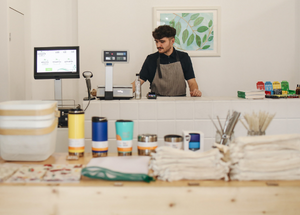Over the past few years, technological advances have reshaped the way we shop.  The installation of cashier-less checkouts majorly changed the retail landscape. Self-serve checkouts certainly help the flow of customers in busy times, but does this convenience cut into the merchant’s possible profits?
The installation of cashier-less checkouts majorly changed the retail landscape. Self-serve checkouts certainly help the flow of customers in busy times, but does this convenience cut into the merchant’s possible profits?
Today’s technologies make it too easy for shoppers to fly through the point-of-sale and right on out the door without feeling the slightest temptation to make an impulsive purchase at the front end.
Before self-checkouts and checkout-less sales, cashiers helped slow customer traffic, allowing a bit of extra time for the surrounding merchandise to trigger an impulse. Front-end merchandising must be part of a business’s sales analysis if profits are to be maximized.
Merchants must find a way to attract shoppers’ attention to the products before customers have a chance to engage with the technology responsible for completing the sale. Shoppers cannot be allowed to tunnel their vision onto that device. Their sights should be set, instead, on the products within their arms’ reach.
Why Front-end Merchandising Works
Front-end merchandising is a great distraction from checking out. To make sales, successful merchants arrange goods and analyze data to see what sells best at eye level and from nearby racks, tables, and endcaps.
Many items placed at eye level often seem typical: items that satisfy an immediate need like thirst or hunger; easily forgotten items like batteries and bandages; and items for celebrations like party supplies, gift cards, and presents for others or rewards for oneself.
To get customers to notice what else is by the checkout, merchandising is key. When products are organized thematically, shoppers are likely to notice them and investigate the choices within the grouping. This method works especially well for seasonal merchandise. Likewise, cross-merchandising drives sales too.
For example, if a store is having a sale on coolers, bundling coolers with an arrangement of beach towels, sunglasses, and tanning lotion alongside the coolers can generate sales within a few different departments all at the front-end. As shoppers walk to the cashier-less checkout, they need their attention captured by these displays.
Put Products at Eye Level
Speaking of discounts, the front-end is prime real estate for moving products marked down from the original retail price. As with all items in a cashier-less checkout, everything should be accurately priced. Signage advertising discounts should stand out. Experiment with signs of various sizes, shapes, and colors to see what attracts shoppers’ interest. Keep items with the best-perceived value at eye level.
Use case stacks for sale items if other fixtures are full or the items are large or awkward in shape. Case stacks are a great way to merchandise new products in the front end. If cashiers or other sales associates are not available to demonstrate or explain new merchandise to shoppers in the front end, consider installing a screen to play a short, appealing video about it.
Creating a Planogram for Your Merchandise
Before pulling inventory from backstock or other locations on the sales floor, create a planogram to help you decide what the best position will be for merchandise moving to the front end. This will help you determine how much space you have available before you put in the physical labor to get the job done.
Avoid congesting traffic. Your customers don’t want to feel overwhelmed by the amount of merchandise they must pass by to get to the checkout.
Final Thoughts
Every few weeks, be sure to analyze the sales data to track how well each item is selling at its current place. You may find that moving the item to a different location within the front-end may be all that’s needed to generate new sales; conversely, it may need to leave the front end altogether to allow space for something that will sell better.
A great portion of your business will come from repeat customers, and when fresh items appear at the cashier-less checkout, they will often be the ones who make an impulsive purchase.
